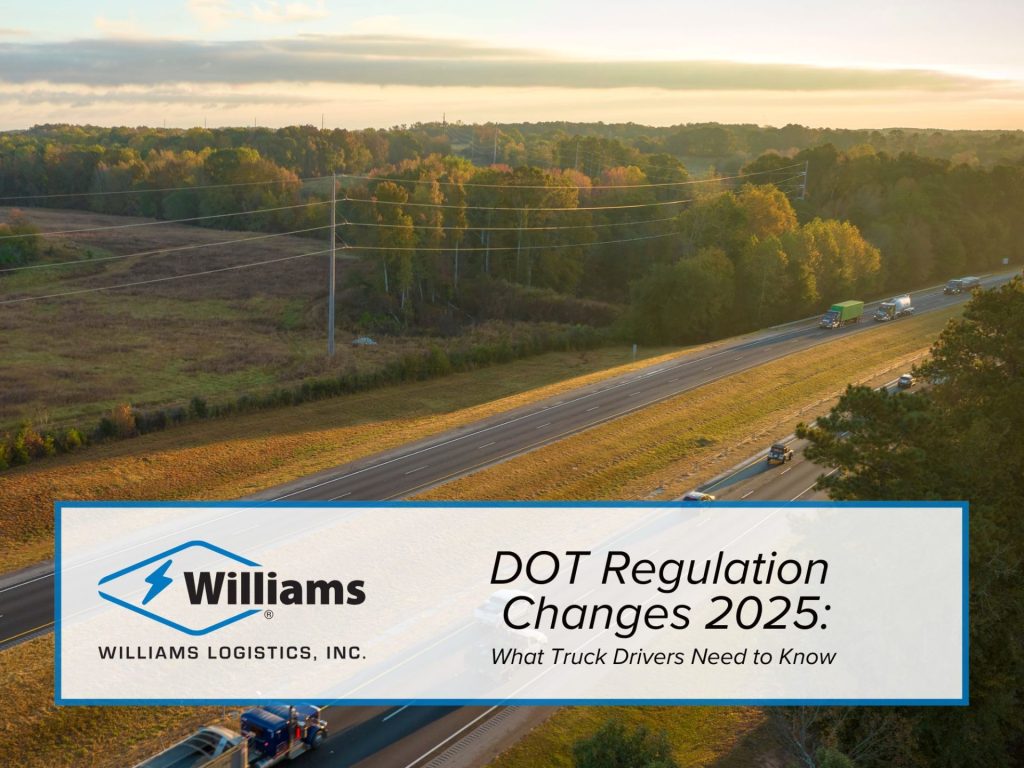The U.S. Department of Transportation (DOT) and the Federal Motor Carrier Safety Administration (FMCSA) are ushering in a new era for the trucking industry in 2025, focusing on streamlining regulations and eliminating outdated, burdensome rules that no longer contribute to safety or efficiency. For fleets like Williams Logistics, these changes are set to make compliance simpler while maintaining the highest standards of roadway safety.
Why Are DOT Regulations Changing?
After years of industry feedback and a government-wide push for deregulation, the DOT recently announced 52 deregulatory actions across its agencies, including 20 from the FMCSA alone. The goal is to remove or amend rules that create unnecessary red tape for truck drivers and fleet operators without enhancing safety.
Transportation Secretary Sean P. Duffy emphasized, “These are common sense changes that will help us build a more efficient government that better reflects the needs of the American people.” The DOT’s approach is to focus on rules that matter for safety and efficiency, while cutting those that are outdated, duplicative, or confusing.
Key Outdated Trucking Regulations on the Chopping Block
Here are some of the notable changes and proposals affecting commercial truck drivers and fleets:
- ELD Operator’s Manual Requirement Removed: Drivers will no longer be required to keep a paper copy of their Electronic Logging Device (ELD) operator’s manual in the truck, as these manuals are now widely available online and drivers are already required to understand their ELD’s operation.
- Spare Fuse Requirement Eliminated: The mandate for carrying spare fuses for every type and size in the vehicle is set to be removed, reducing unnecessary cargo and simplifying pre-trip checks.
- Self-Reporting Traffic Violations No Longer Needed: With electronic exchanges between state licensing agencies now in place, drivers will not have to self-report motor vehicle violations to their home state, streamlining compliance.
- Retroreflective Tape on Older Trailers: The requirement to retrofit trailers built before December 1, 1993, with retroreflective tape will be rescinded, as nearly all trailers in operation today were manufactured after this date and already meet current safety standards.
- Obsolete Equipment and Language: References to liquid-burning flares, “water carriers,” and outdated vision waiver programs are being removed, reflecting current industry practices and technology.
- Rear Impact Guard Certification Label: The need for a permanent certification label on rear impact guards is being dropped, as labels often wear off and the requirement has proven impractical for long-term compliance.
Additional Amendments to Modernize Trucking
FMCSA is also proposing updates to several other rules, including:
- Allowing electronic completion of Driver Vehicle Inspection Reports (DVIRs)
- Updating accident reporting definitions to clarify what constitutes “medical treatment”
- Revising railroad crossing regulations for modern warning systems
- Adjusting requirements for military drivers and auxiliary fuel tanks
What Does This Mean for Williams Logistics Drivers?
For Williams Logistics, these changes mean less paperwork, fewer outdated equipment requirements, and a more straightforward path to compliance. Importantly, none of these deregulatory actions compromise safety; instead, they allow drivers and fleets to focus on what truly matters—safe, efficient, and compliant operations.
As these changes roll out, Williams Logistics will provide updated guidance and training to ensure all drivers are aware of the new requirements and how they affect daily operations.
The bottom line: 2025 marks a significant shift in DOT regulation, with a focus on removing outdated rules and making compliance more practical for today’s trucking industry. At Williams Logistics, we’re committed to keeping our fleet informed, safe, and ahead of the curve as these changes take effect.
